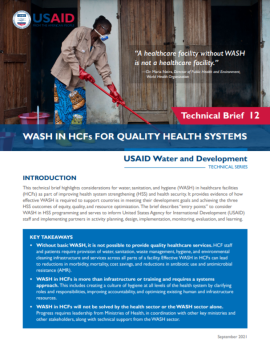This brief is part of USAID 's Water and Development Technical Series, which provides guidance on important topics for developing and implementing water and sanitation activities in support of the U.S. Government Global Water Strategy and USAID’s plan under the strategy.
This technical brief highlights considerations for water, sanitation, and hygiene (WASH) in healthcare facilities (HCFs) as part of improving health system strengthening (HSS) and health security. It provides evidence of how effective WASH is required to support countries in meeting their development goals and achieving the three HSS outcomes of equity, quality, and resource optimization. The brief describes “entry points” to consider WASH in HSS programming and serves to inform USAID staff and implementing partners in activity planning, design, implementation, monitoring, evaluation, and learning.
KEY TAKEAWAYS
- Without basic WASH, it is not possible to provide quality healthcare services. HCF staff and patients require provision of water, sanitation, waste management, hygiene, and environmental cleaning infrastructure and services across all parts of a facility. Effective WASH in HCFs can lead to reductions in morbidity, mortality, cost savings, and reductions in antibiotic use and antimicrobial resistance (AMR).
- WASH in HCFs is more than infrastructure or training and requires a systems approach. This includes creating a culture of hygiene at all levels of the health system by clarifying roles and responsibilities, improving accountability, and optimizing existing human and infrastructure resources.
- WASH in HCFs will not be solved by the health sector or the WASH sector alone. Progress requires leadership from Ministries of Health, in coordination with other key ministries and other stakeholders, along with technical support from the WASH sector.


